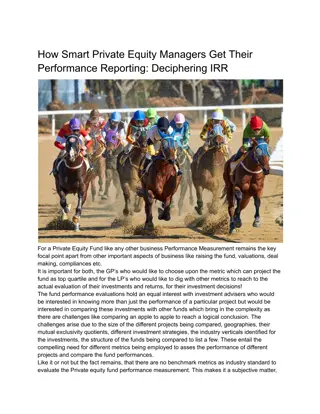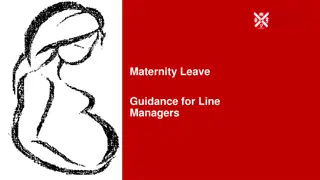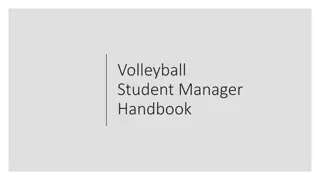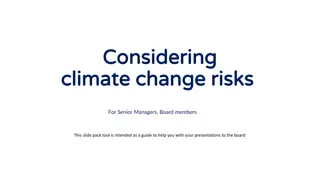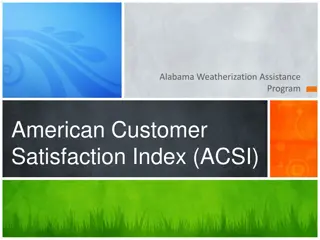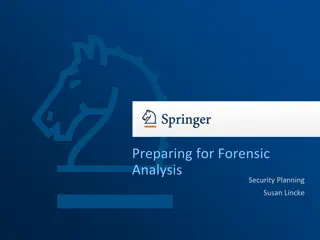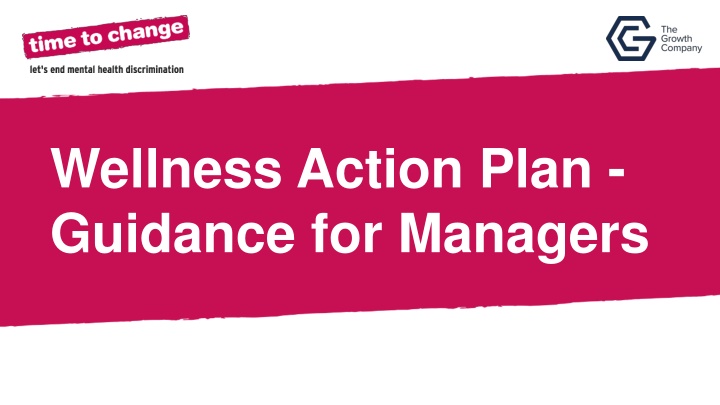
Promoting Mental Health and Wellbeing in the Workplace
Explore the importance of mental health and wellbeing, learn about Wellness Action Plans to support employees, and understand the commitment to mental health advocacy. Discover practical tips and resources for creating a supportive environment at work.
Download Presentation

Please find below an Image/Link to download the presentation.
The content on the website is provided AS IS for your information and personal use only. It may not be sold, licensed, or shared on other websites without obtaining consent from the author. If you encounter any issues during the download, it is possible that the publisher has removed the file from their server.
You are allowed to download the files provided on this website for personal or commercial use, subject to the condition that they are used lawfully. All files are the property of their respective owners.
The content on the website is provided AS IS for your information and personal use only. It may not be sold, licensed, or shared on other websites without obtaining consent from the author.
E N D
Presentation Transcript
Classified: Internal Personal and Confidential Section Title Wellness Action Plan - Guidance for Managers
Classified: Internal Personal and Confidential Contents What is mental health & wellbeing? What is a Wellness Action Plan (WAP)? Why did the GC commit to the Time to Change Pledge? Who is the guide for? Key benefits of the WAP tool Supporting your team members to develop a WAP Reasonable adjustments Top 10 evidence-based tips for promoting good mental health at work
Classified: Internal Personal and Confidential What is mental health & wellbeing? Mental health Some people call mental health emotional health or well-being and it s just as important as good physical health. We all have times when we feel down or stressed or frightened. Most of the time those feelings pass. But sometimes they develop into a more serious problem and that could happen to any one of us (Mental Health Foundation). 1 in 4 people will experience a mental health condition, which means someone you know may be struggling and need further support. Mental wellbeing Mental wellbeing describes your mental state; how you are feeling and how well you can cope with day-to-day life. Our mental wellbeing can change, from day to day, month to month or year to year (Mind).
Classified: Internal Personal and Confidential What is a Wellness Action Plan (WAP)? The Wellness Action Plan (WAP) has been developed as a preventative tool to help promote good mental health and wellbeing. We are trying to shift towards a more proactive and positive approach to wellbeing and believe that this tool can help support our people to promote good mental health. The WAP is not legally binding, but is intended as an agreement between a manager and an employee in order to promote wellbeing or address any existing mental health needs, including any adjustments they may wish to discuss. We introduced this tool as part of our ongoing commitment to the Time to Change Pledge (see next slide).
Classified: Internal Personal and Confidential Why the GC committed to the TTC Pledge We re committed to not only supporting health and wellbeing of our people, but also in creating an environment which encourages open conversation about mental health. We want to raise more awareness that every individual is likely to move between periods of good and poor mental health throughout their lives, and this is completely normal. We value the support of our Champions in playing a leading role in ending stigma around mental health and normalising the conversation in our everyday lives. If you are interested in becoming a Mental Health Champion, then please get in touch.
Classified: Internal Personal and Confidential Who is the guide for? This guide is designed to be a helpful starting point in your journey as a line manager towards supporting your team members with their mental health and wellbeing at work. You might be: Managing someone who is experiencing a mental or physical health condition and want to know more about how you can support them Interested in using the WAP with team members who are currently well, as a proactive tool to promote and maintain their mental health and wellbeing at work An HR professional looking to promote this guide to managers, to help them support the mental wellbeing of their teams
Classified: Internal Personal and Confidential Key benefits of the WAP tool: As a manager, encouraging your team to draw up a WAP gives them ownership of the practical steps needed to help them stay well at work or manage a mental or physical health condition. Managers who choose to introduce new starters to the WAP during the induction process are able to demonstrate their commitment to employee wellbeing from the very beginning, sending out a clear message that proactive management of the wellbeing of their team members matters. It opens up a dialogue between you and your team member, to help you better understand their needs and experiences and therefore better support their wellbeing. This in turn can lead to greater productivity, better performance and increased job satisfaction. If you have team members that work remotely, a WAP can help them identify how best you can support them to overcome any barriers which this style of working can present. WAPs are also particularly helpful during the return to work process if you have been off work due to a mental or physical health condition, as they provide a structure for conversations around what support will help you and what reasonable adjustments might be useful to discuss and consider with your manager.
Classified: Internal Personal and Confidential Section Title Supporting your team members to develop a WAP
Classified: Internal Personal and Confidential First steps As a manager, you will be a key support in encouraging your team members to develop their WAP. You could start by: 1. Giving your team member a copy of our WAP Guidance for Colleagues 2. Asking your team member to have a go at completing the WAP 3. Scheduling some time to discuss their WAP with you and finalise it based on these discussions Remember: The WAP needs to include all the things that are important to the individual s mental wellbeing, from their triggers and signs of poor mental health, to what action to take and what support they need when or if they become unwell. Once the WAP has been drawn up, factor in some time during your KITs to review the WAP and make any necessary changes. The WAP is most effective when treated as a live, flexible document, so a regular feedback loop with your team member to assess what is and isn t working is an important part of the process.
Classified: Internal Personal and Confidential Why Time to Change exists? Confidentiality The WAP should be held confidentially by you and the team member. With the employee being fully aware of how the information will be used, and only providing information that they are happy to share. You should ensure that the personal data, including data relating to health, is handled in accordance with our data protection policy. Any breach of confidentiality will be treated very seriously and dealt with under our disciplinary procedure. If the employee is filling out a WAP as a result of being unwell, you may ask whether they consent for a copy of it to be held with HR, along with any other information about their wellbeing, such as an Occupational Health report or a Return to Work plan (please refer to the Wellbeing Policy for further details). In order for GC to fulfil it s duty of care to keep colleagues safe at work, you will be obliged to break confidentiality if you believe they are experiencing a crisis. If you become aware that they or someone else is at serious risk of harm, you should call the emergency services.
Classified: Internal Personal and Confidential 10 top tips for people managers The WAP is not only a tool to support employees when they are experiencing challenges - it also helps identify how an individual s wellbeing can be proactively improved. Take a look at our tips below on how you can support employee wellbeing: 1. 2. 3. 4. 5. 6. 7. 8. Be available Be open and share any personal struggles or experiences Regularly ask how employees feel and listen to the response; weave wellbeing into the KITs and informal catch ups Trust your people to deliver against clear agreed objectives Be realistic about expectations/timescales Recognise achievement Explore with an open mind, reasons for lack of achievement Be supportive, approachable and responsive, ensuring that you are available for regular work-related conversations and increasing the frequency of supervision or catch-up time with the team member if required Proactively support employees to monitor their workload and encourage healthy working hours and a positive work/life balance. Avoid encouraging presenteeism by acting as a good role model; taking breaks and annual leave 10. Give permission to employees to stop and take a break when needed 9.
Classified: Internal Personal and Confidential Supporting a colleague If someone in your team discloses their mental health condition to you, you may wish to read up on it a little so that you have a basic understanding of what they might be experiencing. Do remember though that it is not your role to provide medical advice, and a specific condition is often experienced very differently by different people, so try not to make assumptions. Focus on what you as a manager can do to support the individual, rather than offering advice. We ve listed some tips below: When talking about mental health, listen, be respectful and do not make assumptions. Be positive focus on what employees can do, rather than what they can t, providing training, mentoring or coaching if there are skills gaps. Recognise and praise good work and commitment, providing regular opportunities to discuss, review and reflect on positive achievements; this helps to build positive self-esteem and develop skills to better manage triggers for poor mental health. Encourage employees to seek further advice and professional support when needed. Offer additional support (see Wellbeing Policy) including EAP, MHFA and Occupational Health etc. Speak to your HR contact for additional support and guidance
Classified: Internal Personal and Confidential Example case study
Classified: Internal Personal and Confidential Reasonable adjustments and the Equality Act, 2010 As a result of an employee completing a WAP, you might discuss with your team member whether any reasonable adjustments are needed. A reasonable adjustment is an alteration which enables an employee (who is disabled or has a physical or mental health condition) to continue with their duties without being at a disadvantage compared to others. Further details can be found on the government website. The types of reasonable adjustments commonly made for people experiencing a mental or physical health condition depends on the symptoms being experienced, and should be tailored to suit the employee. It also depends on the Company s resources, so as part of your role as the manager, you need to be aware of what the GC is able to provide and what is defined as reasonable when entering into a conversation.
Classified: Internal Personal and Confidential Examples of reasonable adjustments Providing written instructions for someone whose anxiety affects their memory Providing workload support and help with prioritising work Agreeing the type of work you can handle whilst you are on a phased return to work Increasing frequency of Keeping in Touch meetings (KITs) or 1-to-1 s Flexible working hours, for example, allowing a person who has difficulty travelling in crowded trains to start early and finish early in order to avoid the rush hour Appointing a buddy as additional support and to regularly check-in with your team member Arranging for someone who finds the distractions of an open-plan office detracts from their work performance to have a desk in a quieter area
Classified: Internal Personal and Confidential Top 10 evidence-based tips for promoting good mental health at work which you can share with your team 1. Keep active; try and take a walk or get some fresh air during the day. Exercise and daylight are good for your mental health as well as physical health Eat well and keep hydrated Prioritise quality sleep; learn some relaxation techniques if you struggle to switch off (relaxing and calming exercises) Take breaks away from your desk (schedule in your diary if possible) and take annual leave throughout the year to ensure you have time off on a regular basis to recharge Maintain regular social contact with colleagues, friends, family (e.g. weekly virtual brew and chat) Be kind to yourself and others Talk to someone you trust at work or outside about how you feel and don t feel ashamed to ask for help if you feel like you need additional support Write a list of what needs to be done; it only takes a few minutes and can help you to prioritise, focus and get things in perspective. It can also feel satisfying to tick items off once they have been done! Be realistic when agreeing to timescales for deadlines. If you feel you need further support with managing workload then speak to your manager to discuss any additional support that might be available. 10. Plan time for self-care; something you enjoy doing or that makes you feel happy 2. 3. 4. 5. 6. 7. 8. 9.
Classified: Internal Personal and Confidential Wellbeing resources A wide variety of health and wellbeing related training is available to access via our learning platform P.A.L App Employee Assistance Programme (EAP), provided by Health Assured, is available to you and your immediate family 24/7 by calling the free confidential helpline 0800 030 5182 or visiting the online portal (Username: Growth, Password: Company). Active Care is a free service available for those who are absent for stress from day 1 During working hours, you can access support from our Mental Health First Aiders Mind for further information and support on mental health and wellbeing Mental Health and Wellbeing Policy for further details and signposting Samaritans or phone to talk to someone for free: 116-123 Referral for Occupational Health Assessments or liaising with other medical professionals for medical advice (please speak to HR for further details). Eight relaxation tips to look after your mental health If you are feeling anxious, the Bupa interactive worry tree may help to reflect on the cause of any worries and suggests differing coping techniques A healthy lifestyle can also improve your mental and physical wellbeing and overall affect how you feel about change in general. Our Working Way hub for additional resources and guidance
Classified: Internal Personal and Confidential WAPs in Action WAPs in Action 1. DEVELOPING A WAP OF YOUR OWN WITH YOUR MANAGER CAN BE A HELPFUL WAY OF KEEPING TRACK OF WHAT KEEPS YOU WELL AND ENSURING YOU RE LOOKING AFTER YOUR OWN NEEDS TOO. Often the necessary change is one of attitude, expectations or communication rather than a major or costly change. As a manager, be as creative as possible when thinking about how to address the specific needs of your team members. WAPs are most effective when they explore their individual needs and put in place practical, easy to implement approaches or adjustments based on these needs. If you have any feedback or questions about the WAP form/guidance, please get in contact. If you have any concerns or the employee requires further professional support such as Occupational Health, then please speak to your HR contact for further details. 2. NOW START ENCOURAGING YOUR TEAM TO CREATE THEIR OWN WELLNESS ACTION PLAN. 3. BY REGULARLY REVIEWING THE WAP WITH YOUR TEAM MEMBERS, THEY CAN ADAPT IT TO REFLECT CHANGES IN THEIR EXPERIENCES OR NEW APPROACHES THEY FIND HELPFUL, AND BY BEING PROACTIVE AND TAKING OWNERSHIP OF THE PROCESS AND OF THE WAP ITSELF, IT MAY HELP EMPLOYEES FEEL MORE IN CONTROL.




